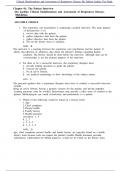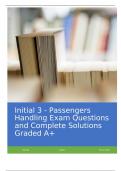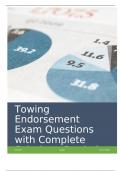Clinical zManifestations zand zAssessment zof zRespiratory zDisease z8th zEdition zJardins zTest zBank
Chapter z01: zThe zPatient zInterview
Des zJardins: zClinical zManifestations zand zAssessment zof zRespiratory zDisease,
z8thzEdition
MULTIPLE zCHOICE
1. The zrespiratory zcare zpractitioner zis zconducting za zpatient zinterview. zThe zmain zpurpose
zof zthiszinterview zis zto:
a. review zdata zwith zthe zpatient.
b. gather zsubjective zdata zfrom zthe zpatient.
c. gather zobjective zdata zfrom zthe zpatient.
d. fill zout zthe zhistory zform zor zchecklist.
ANS: z B
The zinterview zis za zmeeting zbetween zthe zrespiratory zcare zpractitioner zand zthe zpatient. zIt
zallows zthezcollection zof zsubjective zdata zabout zthe zpatient’s zfeelings zregarding zhis/her
condition. zThe zhistory zshould zbe zdone zbefore zthe zinterview. zAlthough zdata zcan zbe
zreviewed,zthat zis znot zthe zprimary zpurpose zof zthe zinterview.
2. For zthere zto zbe za zsuccessful zinterview, zthe zrespiratory ztherapist zmust:
a. provide zleading zquestions zto zguide zthe zpatient.
b. reassure zthe zpatient.
c. be zan zactive zlistener.
d. use zmedical zterminology zto zshow zknowledge zof zthe zsubject zmatter.
ANS: C
z
The zpersonal zqualities zthat za zrespiratory ztherapist zmust zhave zto zconduct za zsuccessful zinterview
zinclude
being zan zactive zlistener, zhaving za zgenuine zconcern zfor zthe zpatient, zand zhaving zempathy.
zLeading zquestions zmust zbe zavoided. zReassurance zmay zprovide za zfalse zsense zof zcomfort zto zthe
zpatient. zMedicalzjargon zcan zsound zexclusionary zand zpaternalistic zto za zpatient.
3. Which zof zthe zfollowing zwould zbe zfound zon za zhistory zform?
1. Age
2. Chief zcomplaint
3. Present zhealth
4. Family zhistory
5. Health zinsurance
zproviderza. z1, z 4
b. z2, z3
c. z3, z4, z5
d. z1, z2, z3, z4
ANS: z D
Age, zchief zcomplaint, zpresent zhealth, zand zfamily zhistory zare ztypically zfound zon za zhealth
zhistory zform zbecause zeach zcan zimpact zthe zpatient’s zhealth. zHealth zinsurance zprovider
zinformation, zwhilezneeded zfor zbilling zpurposes, zwould znot zbe zfound zon zthe zhistory zform.
,NURSINGTB.COM
, 4. External zfactors zthe zrespiratory zcare zpractitioner zshould zmake zefforts zto zprovide
zduring zanzinterview zinclude zwhich zof zthe zfollowing?
1. Minimize zor zprevent zinterruptions.
2. Ensure zprivacy zduring zdiscussions.
3. Interviewer zis zthe zsame zsex zas zthe zpatient zto zprevent zbias.
4. Be zcomfortable zfor zthe zpatient zand
zinterviewer.za. z1, z 4
b. z2, z3
c. z 1, z2, z 4
d. z z z2, z3, z4
ANS: z C
External zfactors, zsuch zas za zgood zphysical zsetting, zenhance zthe zinterviewing zprocess. zRegardless
zof zthe zinterview zsetting z(the zpatient’s zbedside, za zcrowded zemergency zroom, zan zoffice zin zthe
zhospital zor zclinic,zor zthe zpatient’s zhome), zefforts zshould zbe zmade zto z(1) zensure zprivacy, z(2)
zprevent zinterruptions, zand z(3)zsecure za zcomfortable zphysical zenvironment z(e.g., zcomfortable
zroom ztemperature, zsufficient zlighting, zabsence zof znoise). zAn zinterviewer zof zeither zgender, zwho
zacts zprofessionally, zshould zbe zable zto zinterview za zpatient zof zeither zgender.
5. The zrespiratory ztherapist zis zconducting za zpatient zinterview. zThe ztherapist zchooses
zto zusezopen-ended zquestions. zOpen-ended zquestions zallow zthe ztherapist zto zdo
zwhich zof zthe zfollowing?
1. Gather zinformation zwhen za zpatient zintroduces za znew ztopic.
2. Introduce za znew zsubject zarea.
3. Begin zthe zinterview zprocess.
4. Gather zspecific zinformation.
a. z4
b. z1, z3
c. z 1, z2,
z3
d. z z z2, z3,
z4
ANS:
z C
An zopen-ended zquestion zshould zbe zused zto zstart zthe zinterview, zintroduce za znew zsection zof
zquestions,zand zgather zmore zinformation zfrom za zpatient’s ztopic. zClosed zor zdirect zquestions zare
zused zto zgather zspecific zinformation.
6. The zdirect zquestion zinterview zformat zis zused zto:
1. speed zup zthe zinterview.
2. let zthe zpatient zfully zexplain zhis/her zsituation.
3. help zthe zrespiratory ztherapist zshow zempathy.
4. gather zspecific
zinformation.za. z1, z 4
b. z z z2, z3
c. z 3, z 4
d. z z z1, z2, z3
ANS: z A
Direct zor zclosed zquestions zare zbest zto zgather zspecific zinformation zand zspeed zup zthe
zinterview. zOpen- zended zquestions zare zbest zsuited zto zlet zthe zpatient zfully zexplain zhis/her
zsituation zand zpossibly zhelp zthezrespiratory ztherapist zshow zempathy.
, 7. During zthe zinterview zthe zpatient zstates, z―Every ztime zI zclimb zthe zstairs zI zhave zto zstop
zto zcatchzm y zbreath.‖ zHearing zthis, zthe zrespiratory ztherapist zreplies, z―So, zit zsounds
zlike zyou zget zshort zof zbreath zclimbing zstairs.‖ zThis zinterviewing ztechnique zis zcalled:
a. clarification.
b. modeling.
c. empathy.
d. reflection.
ANS: z D
With zreflection, zpart zof zthe zpatient’s zstatement zis zrepeated. zThis zlets zthe zpatient zknow
zthat zwhatzhe/she zsaid zwas zheard. zIt zalso zencourages zthe zpatient zto zelaborate zon zthe
ztopic.
Clarification, zmodeling, zand zempathy zare zother zcommunication ztechniques.
8. The zrespiratory ztherapist zmay zchoose zto zuse zthe zpatient zinterview ztechnique zof
zsilencezin zwhich zof zthe zfollowing zsituations?
a. To zprompt zthe zpatient zto zask za zquestion
b. After za zdirect zquestion
c. After zan zopen-ended zquestion
d. To zallow zthe zpatient zto zreview zhis/her zhistory
ANS: z C
After za zpatient zhas zanswered zan zopen-ended zquestion, zthe zrespiratory ztherapist zshould zpause
z(use zsilence) zbefore zasking zthe znext zquestion. zThis zpause zallows zthe zpatient zto zadd zsomething
zelse zbeforezmoving zon. zThe zpatient zmay zalso zchoose zto zask za zquestion.
9. To zhave zthe zmost zproductive zinterviewing zsession, zwhich zof zthe zfollowing ztypes zof
N zR zI zG zB.C
zresponseszto zassist zin zthe zinterview zshouUld ztShe zrNespTiratory ztOherapist zavoid?
a. Confrontation
b. Reflection
c. Facilitation
d. Distancing
ANS: z D
With zconfrontation, zthe zrespiratory ztherapist zfocuses zthe zpatient’s zattention zon zan zaction,
zfeeling, zorzstatement zmade zby zthe zpatient. zThis zmay zprompt za zfurther zdiscussion. zReflection
zhelps zthe zpatient zfocus zon zspecific zareas zand zcontinues zin zhis/her zown zway. zFacilitation
zencourages zpatients zto zsay zmore, zto zcontinue zwith zthe zstory. zThe zrespiratory ztherapist zshould
zavoid zgiving zadvice, zusing zavoidance zlanguage, zand zusing zdistancing zlanguage.
10. When zclosing zthe zinterview, zthe zrespiratory ztherapist zshould zdo zwhich zof zthe zfollowing?
1. Recheck zthe zpatient’s zvital zsigns.
2. Thank zthe zpatient.
3. Ask zif zthe zpatient zhas zany zquestions.
4. Close zthe zdoor zbehind zhimself/herself zfor zpatient zprivacy.
a. z2
b. z2, z3
c. z1, z3, z4
d. z1, z2, z4 zANS: z B






